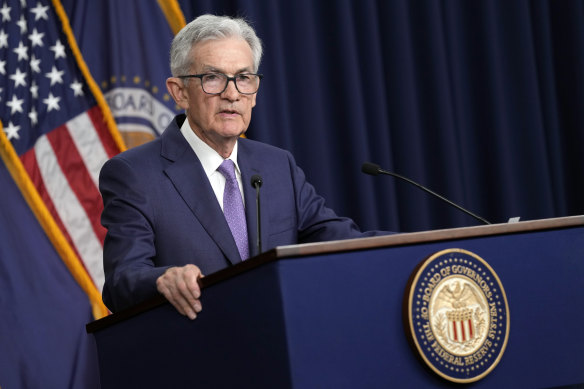This was published 1 year ago
Opinion
How the Trump-Biden debate increased the chance of a rate rise in Australia
Stephen Bartholomeusz
Senior business columnistOver the past few days, yields in the Australian bond market have risen across the yield curve and the curve has steepened. That could have been a response to the May inflation (CPI) released last month, but it might also have something to do with Joe Biden and Donald Trump.
The Australian Bureau of Statistics (ABS) released the CPI data on June 26, which showed an unexpected and material rise in monthly inflation.

A debate watch party at the Nite Owl Drive-In theater in Miami, Florida.Credit: Bloomberg
Over the next two days the yield on the benchmark 10-year Australian government bond rose 21 basis points, from 4.2 per cent to 4.41 per cent, as the market absorbed the prospect of the Reserve Bank leaving the cash rate remaining unchanged for longer than expected, or even raising it.
Last Friday, the yield on those bonds fell back 10 basis point to 4.31 per cent, before bouncing back this week to 4.43 per cent.
What happened late last week that might explain the spike over the past few days? Joe Biden’s disastrous performance in the debate with Donald Trump.
It might appear odd that a shift in perceptions of the likely outcome of an election in another country might have an influence over the Australian bond market, but it has been well established over a very long time that what happens in the US financial markets generally matters here.
The US Treasury market, in particular, is the world’s biggest, most liquid and most trusted market for securitised debt. Developments in that $US27 trillion-plus market drive massive flows of capital around the globe that impact other bond markets and therefore market interest rates in those economies.
The size of the US financial markets and the US dollar’s dominance in global finance and trade mean those capital flows also impact the value of other currencies, whether they are pegged to the US dollar or, like the Australian dollar, free-floating.
Those external influences and their impact on domestic economic settings are taken into account by central banks outside the US, including the RBA, when setting their own monetary policies.
While particular events, like the unimpressive presidential debate and its implications for the November election, might cause near-term blips in yields in the US and other bond markets, it is the Federal Reserve’s monetary policies that are likely to have longer-term and more profound effects.
Trump’s policies, if enacted, would probably lead to a big surge in the US inflation rate.
Those policies will be heavily influenced by the winner of the presidency and the balance of Congress after the election.
If enacted, Trump’s policies would probably lead to a big surge in the US inflation rate and force the Fed (if it isn’t hobbled) to raise US interest rates, and therefore possibly global rates, relative to what they might otherwise have been.
Last week, the Bank for International Settlements (BIS), which is the central bank for central banks, released a research paper entitled “The Asymmetric and Persistent Effects of Fed Policy on Global Bond Yields.”
While it is highly technical, the paper did conclude that US monetary policy surprises do have lasting impacts on yields elsewhere, albeit impacts that have changed significantly since the 2008 global financial crisis.
Before the GFC, the researchers say, monetary tightening shocks used to produce a pronounced “hump-shaped” increase in US Treasury yields across all maturities.
The responses to unexpected monetary policy easings were, however, modest because term premia (the extra yields investors require for buying longer-duration bonds and therefore locking in an exposure to risks over a longer period) would rise strongly and offset the expected decline of the Fed’s policy rate.
Since the GFC, however, terms premia have been declining persistently following both tightening and easing surprises, with post-GFC tightening shocks having only a transitory positive effect on yields before that impact reverses.
The BIS study said the responses of advanced and emerging markets essentially mimicked patterns seen in the US bond market.

US Federal Reserve chairman Jerome Powell.Credit: AP
In other words, because what happens in the US bond market produces echoes elsewhere, what happens in the US matters for interest rates and monetary policies elsewhere.
It would seem obvious to conclude that the bond market’s response to unexpected shifts in monetary policy that occurred after the GFC was driven by the unconventional monetary policies that the Fed and other central banks deployed in response to that crisis. The remains of those policies are still in force in the US, Europe, and Japan today.
The BIS researchers, however, say that the change doesn’t appear to stem from the adoption of quantitative easing, the large-scale buying of bonds and other securities that the Fed and other major central banks embarked on in response to the GFC and have maintained, to varying degrees, ever since.
The Fed is still reinvesting the proceeds from some of the bonds and mortgages it bought during its quantitative easing programs in new, albeit reduced, purchases of bonds and mortgages.

The US markets aren’t convinced the Fed can pull off the tricky task of producing a “Goldilocks” outcome.Credit: AP
In the post-GFC environment, both yields and term premia have declined “in a protracted manner” following unexpected Fed easings of monetary policy and, after a brief initial increase, they fall persistently after an unexpected tightening. That’s true for both US and global bonds.
The BIS study provides some potential explanations for why bond yields have changed in the post-GFC period, pointing to a structural shift in US dealer balance sheets and mutual fund flows.
Post-GFC, bond market dealers changed the nature of their balance sheets as the Fed’s monetary policy easings sparked “substantial and highly persistent” inflows to mutual funds invested in the sovereign debt of advanced and emerging market economies.
It is possible, therefore, that rather than unconventional monetary policies, changes in prudential regulation, the behaviour of financial institutions, and the explosive growth of the non-bank sector (particularly the funds management sector) in the post-crisis era have altered the way markets respond to changes in monetary policy.
Shifts in the Fed’s policies or material movements in the yields on Treasuries do, of course, have other effects.
A tightening of US financial conditions flows through to global risk aversion, lower asset prices, deleveraging by global financial intermediaries, reduced access to credit and pressure on exchange rates that then flow through to local interest rates. The loosening of US policy has the opposite effect.
It might appear odd, even irrational, that a political development in the US or a shift in US monetary policy can have meaningful effects on interest rates and monetary policies more broadly in Australia and elsewhere.
However, the role that the US, its central bank, its bond market and its currency play within the global economy and financial system means that a debate between two elderly and less-than-impressive politicians could send ripples of unease throughout the global system.
The Business Briefing newsletter delivers major stories, exclusive coverage and expert opinion. Sign up to get it every weekday morning.